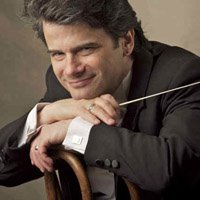by Robert Rollin

Scheherazade is a marvelous programmatic piece with four episodes in the Sultana’s succession of a thousand and one tales which enthrall the Sultan so much that he forgets to execute her as he had all other wives after their wedding nights. Through her guile and storytelling skill, Scheherazade survives and becomes his permanent bride. The composer used the concertmaster’s solo violin to portray Scheherazade’s story-telling ability and as a means of uniting all four movements, not only with musical timbre, but also with Scheherazade’s theme.
The first movement, The Sea and Sinbad’s Ship, began beautifully with the conductor giving worthwhile emphasis to the lovely overlapping octave figures that move from section to section, and instrument to instrument. The care taken with this simple ornamental element truly separated the performance from many others.
The orchestra was clearly excited and well-prepared, and the soloists and sections played their hearts out from the outset. Concertmaster Calvin Lewis’ssd magnificent opening solo set the tone. Principal Flute Kathryn Umble, Principal Oboe Cynthia Watson, Principal Clarinet Deborah Alexander, and Principal Cello Michael Gelfand were all terrific in their solos, and conductor Randall Fleischer seemed electrified as he brought out the wonderful rapid-fire interplay among soloists and sections.
The second movement, The Story of the Kalendar Prince, added Principal Bassoon Kathryn E. Brooks’ fine solos to the mix, as well as some additional lovely coloristic devices, including sparkling woodwind section doublings with piccolo, a powerful string section theme restatement, an interesting doubling of piccolo and trumpet, string pizzicato accompaniments, first class solos in principal horn and principal cello, and extensive low brass playing.
The third movement, The Young Prince and the Young Princess, was more delicately scored and featured the cello section, excellent successive solos in principal flute, oboe, clarinet, violin, French horn, and fine percussion playing. The glorious, rapid interplay of soloists and sections continued.
The final movement was called Festival in Bagdad: The Sea: The Ship Goes to Pieces Against a Rock Surmounted by a Bronze Warrior, and began with concertmaster Lewis’ deft restatement of Scheherazade’s theme. The intermittently intense breakneck tempo, appropriate to the subject, was well controlled by Fleischer and the ensemble. Among the coloristic sleight of hand were an exciting unison restatement of the opening theme, Scheherazade’s theme now as a full orchestral presentation, and a particularly skillful virtuosic solo by the concertmaster ending with a stratospheric sustained pitch as the piece came to a wonderful close.
Brahms’ Symphony No 2 in D Major was equally well played in the second half. The slightly smaller woodwind section, and Brahms’s penchant for dark orchestral timbre made the piece seem more serious. His complex layering of musical ideas and intricate changes in metric groupings combined to demand more of the audience. More than any previous composer Brahms cast sustained focus on the French horns, and the Youngstown Symphony horn section rose to the task.
The first movement, Allegro non troppo, is proportionately longer than the others. It has a wealth of eight different and sometimes interrelated themes. From the opening of low strings answered by the memorable French horn theme, it was clear that the performance was to keep a brisk pace. The cellos were very expressive on the beautiful second theme group. Strong solos in principal flute, principal oboe, and principal French horn set the tone for a great rendition. The brisk tempo never flagged.
The expressive slow movement, Adagio non troppo, continued the focus on French horn color. Principal French horn Heather Johnson was simply glorious throughout the movement. There is an early emphasis on the low strings later joined by the violins. All sections played well.
The third movement, Allegretto grazioso, quasi andantino, has an engaging first theme that is answered by a second theme different in character and yet interrelated motivically. This is typical of Brahms’ multilayered complexity. Two more themes follow, with the last one moving to a lilting three-eighth meter and providing a wonderfully pastoral placid close.
The finale, Allegro con spirito, begins with a multifaceted first theme that shows a friendly nod to Beethoven. It emphasizes the middle of the alla breve meter in both guises. The third theme is a bit syncopated, and the fourth uses a kind of Scottish snap to propel the glorious music forward. Clarinet, oboe, bassoon, and French horn solos were lovely and the brass punctuated the tutti sections well—truly an excellent conclusion to a great concert.
Published on ClevelandClassical.com April 15, 2013
Click here for a printable version of this article.



